If you’re reading this article, chances are you’re thinking about buying a powder board so you can make the most out of those dreamy powder days.
Especially if you’re planning a trip to a resort famous for powder snow, you’ve probably thought: “This time, I’m bringing a powder board!”
Here in Hokkaido’s Rusutsu and Niseko area, where we’re based, we get tons of light, dry powder every season—some of the best snow in the world.
Of course, we instructors all have our own powder boards too, and honestly, riding powder on a powder-specific board is pure joy!
However, there are many types and brands of powder boards out there.
If you choose one just based on a quick store explanation, you might end up disappointed—your board may not perform as you imagined, and it could end up collecting dust after only a few rides.
So in this article, as active snowboarding instructors, we’ll explain everything from the basics of what a powder board is, to how to choose the right one, and finally, our top recommended powder board brands.
What Makes a Powder Board Different?
So, how is a powder board different from a regular all-mountain board?
A powder board is specifically designed to ride smoothly and effortlessly on deep, untouched powder snow. Its shape and construction are quite different from standard boards. Let’s take a closer look at those differences.
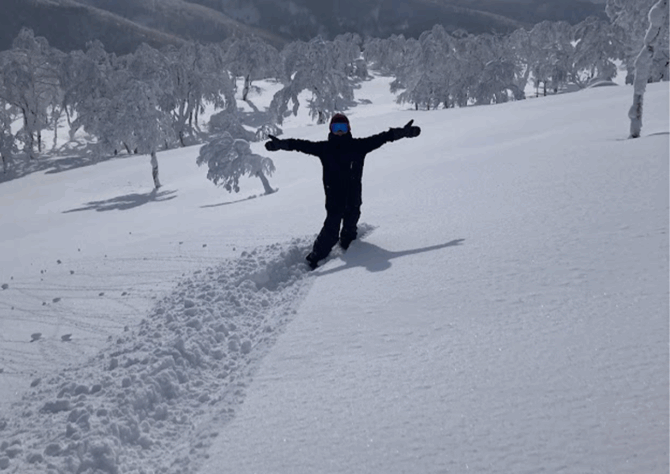
Waist Width
The waist refers to the width of the board.
Powder boards are designed with a wider waist than regular boards.
The reason is simple: a wider board has a larger surface area in contact with the snow, which helps it float better in deep powder.
Length
Powder boards also tend to be longer than standard boards.
This added length provides more floatation in deep snow.
Some brands do make shorter “mini powder” models, but most riders prefer longer boards for better stability and float.
That said, longer doesn’t automatically mean better—both shorter and longer boards have their pros and cons:
| Length | Advantages | Disadvantages |
|---|---|---|
| Shorter | Easier to maneuver Great for tight tree runs Can handle small tricks and buttering | Less stable at high speed May lack float in deep powder |
| Longer | Excellent float and stability in deep snow Stable at higher speeds | Harder to make quick turns Difficult in tight trees Not ideal for freestyle tricks |
We’ll go into more detail later, but the ideal length depends on your riding style and where you plan to ride.
If you’re heading deep into the backcountry, tackling steep lines and don’t care about tricks, a longer board is the clear choice.
If you prefer sidecountry runs near the resort and like to throw in a few tricks, a shorter board will feel more natural.
Setback
Setback means the bindings are mounted slightly toward the tail, shifting your stance back from the center of the board.
This makes the nose longer than the tail, helping it float more easily in deep snow.
Because powder riding requires your weight to be slightly farther back for stability and float, most powder boards feature a directional shape with setback.
In contrast, typical all-mountain boards are twin tip or nearly twin in shape, allowing you to ride switch easily.
Nose Shape
Another defining feature of powder boards is the wider, more rockered nose compared to the tail.
This wider and more uplifted nose increases floatation, and by narrowing the tail, the design helps the nose stay up naturally in deep snow.
Price
While not a shape feature, it’s worth noting that powder boards tend to be more expensive.
Why? Simply because they’re produced in smaller quantities.
Beginners rarely start with a powder board, and riders focused on park or carving don’t usually buy one either.
As a result, production runs are limited, which drives the price per board higher.
Since powder boards are a bit of an investment, it’s worth taking the time to find one that truly suits your needs.
How to Choose a Powder Board
Now that we’ve covered how powder boards differ from all-mountain boards, let’s look at what to consider when choosing one.
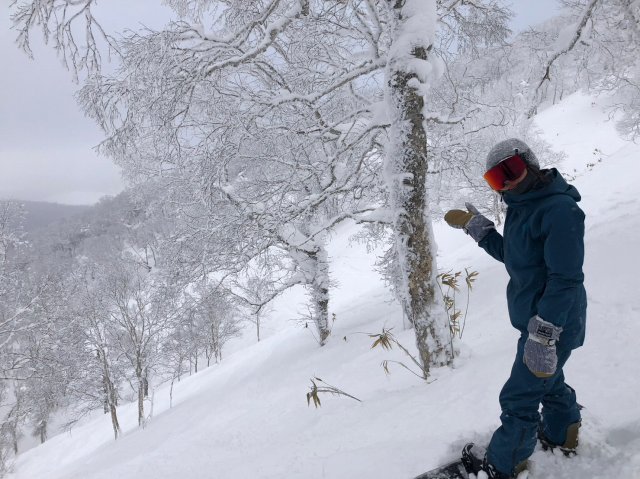
Where Will You Ride?
Think about where you plan to ride your powder board.
Will it be:
Open backcountry fields with deep, untouched snow?
Tight tree runs in sidecountry zones?
Powder stashes at the edge of the resort?
The ideal board depends heavily on the terrain.
If you buy a board without considering this, you might end up with something too high-spec or not capable enough for your riding environment.
Before you buy, decide what kind of powder and terrain you’ll be riding most often.
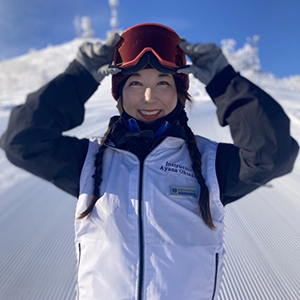
I once bought a super high-end powder board designed for deep backcountry riding, but since I mostly ride sidecountry, it was total overkill—I could barely use its potential!
So definitely choose a board that matches your usual powder conditions.
Board Length
As mentioned earlier, powder boards are generally longer than standard all-mountain boards.
Length is an important factor when choosing your board.
The general rule of thumb for snowboard length is your height minus about 15 cm, but this doesn’t necessarily apply to powder boards.

I’m 160 cm tall, and I’ve ridden a 155 cm powder board before!
When it comes to powder boards, forget the “minus 15 cm” rule—it doesn’t apply here!
Longer boards give you more stability and float,
but shorter ones are easier to maneuver.
Choose based on your skill level and where you’ll ride most.
For example, if you’re new to powder and mostly plan to enjoy sidecountry tree runs, just pick a board similar in length to your current one,
but with a true powder shape—you’ll still get great float and have tons of fun.
Board Profile: Rocker or Camber?
Powder boards come in both rocker and camber profiles.
A rocker board provides excellent float in deep snow but lacks stability and tends to wash out easily on groomed runs.
A camber board offers better edge hold and turning precision on both groomed and ungroomed snow,
but doesn’t float quite as easily as a rocker.
Neither is “better” — it all depends on your riding style.
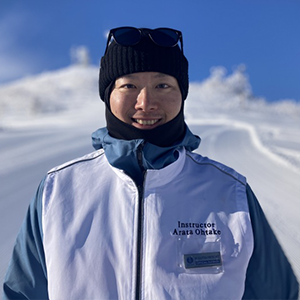
I like to enjoy both powder and carving with one board,
so I always go for a camber-profile powder board!
Nose Shape
Powder board noses generally come in three main shapes:
Round Nose, Pencil Nose, and Square Nose.
・Round Nose
This is the most common shape, easy to adapt to if you’re switching from an all-mountain board.
It provides excellent float in open powder fields and remains stable at high speeds.
Because the nose is heavier, it can feel a bit sluggish when making quick turns in tight trees until you get used to it.
・Pencil Nose
This shape features sharper edges at the nose, making turn transitions quicker and lighter.
It still offers plenty of float, working well for both open terrain and tree runs.
・Square Nose
As the name suggests, the nose is cut into a squared shape, making the board lighter and more maneuverable.
It’s highly responsive and agile, though it offers slightly less float compared to the other two.
Here’s a quick guide to which nose shape suits which type of rider:
| Nose Shape | Best For |
|---|---|
| Round Nose | Riders who just want to enjoy deep powder Those who ride open, wide powder fields Riders who like speed in powder |
| Pencil Nose | Tree run lovers Riders who want easy turns in powder Those who want moderate float |
| Square Nose | Riders who want to enjoy both groomers and powder Those who prefer quick, light turns Riders who don’t go super fast in powder |
Tail Shape
Powder boards are also unique in their tail shapes.
Since edges don’t grip well in deep snow, you use the tail to control speed and turns.
The tail design therefore affects how your board feels in powder.
The main types are:
Diamond Tail, Swallow Tail, Half-Moon Tail, Round Tail, and Pin Tail.
・Diamond Tail
The shortened tail makes the board much easier to maneuver in deep powder.
It’s perfect for beginners or riders who mainly enjoy tree runs and sidecountry terrain.
・Swallow Tail
When you think of a powder board, this is probably the classic shape that comes to mind.
The Swallow Tail helps you maintain speed even on gentle slopes and prevents you from slowing down in deep snow.
However, because the tail surface area is so small, putting too much weight on the back will cause you to decelerate.
・Half-Moon Tail
This design offers both easy turn control and stable speed management,
making it a great option for powder beginners.
It also provides decent float, working well in everything from open fields to tree runs.
・Round Tail
A round tail provides plenty of float thanks to its larger surface area, but because it also has more contact with the snow, it tends to generate more drag and can feel slower.
However, since its shape is similar to most all-mountain boards, it’s easier to perform tricks on and feels more natural when riding switch.
If you love powder tree runs where the trees are dense, there are often moments when you think, “I can’t go any farther this way—time to switch directions!” In those situations, you’ll naturally end up riding switch, so a round tail board is perfect for riders who spend most of their time in the trees.
・Pin Tail
The pin tail is designed with an elongated, tapered tail to enhance float. Because the tail is longer and narrower, it sinks less easily and allows smoother turning in deep powder.
For riders who are new to powder, it’s common to lean too far back and lose balance—but a pin tail makes it easier to stay centered even if your weight shifts too far back. It’s a forgiving shape and great for those still learning powder control.
Recommended Tail Shapes by Riding Style
| Tail Shape | Recommended For |
|---|---|
| Diamond Tail | • Riders who mainly ride tree runs or sidecountry terrain • Those who also like to carve depending on snow conditions |
| Swallow Tail | • Riders who mainly ride open bowls or backcountry terrain |
| Half Moon Tail | • Riders who enjoy tree runs or sidecountry • Those who carve when conditions are right |
| Round Tail | • Riders who tackle dense tree runs • Those who want to do tricks |
| Pin Tail | • Powder beginners who tend to sink easily • Riders who still want to make solid turns in deep snow |
Choose Your Powder Board Based on Your Ideal Riding Style
If you’ve made it this far and are thinking, “There are so many shapes—how do I even choose?” you’re not alone.
In my opinion, the best way to pick a powder board is to start with the kind of snowboarding style you want to achieve.
Below are several riding styles and tips on which type of powder board fits each. Think about which one sounds most like you.
For riders who want to flow through sidecountry terrain and use natural features
Some powder riders don’t just love the feeling of floating—they love exploring the mountain itself.
If you enjoy darting between trees, slashing natural halfpipes, jumping off mushroom-shaped snow bumps, or sliding across fallen logs, you’re that type of creative freerider everyone admires.
For this style, choose a board that prioritizes maneuverability over high-speed stability.
Recommended setup:
Nose shape: Pencil nose or square nose
Tail shape: Round tail
Length: On the shorter side for a powder board
For riders who want effortless tree runs
Open powder bowls are amazing, but weaving between trees like a maze has its own magic.
Tree runs require instant board control, so you’ll want a highly responsive setup that’s easy to handle. Losing balance here could mean colliding with a tree, so smooth, agile control is key.
Recommended setup:
Nose shape: Square nose
Tail shape: Round, diamond, or half-moon tail
Length: Short for a powder board
Waist width: Narrower than usual
Profile: Camber
For those who love both powder and carving
Maybe you love that floating powder feeling but also crave the thrill of carving clean arcs on a groomed slope depending on the day.
I’m that type too—powder and carving are both irresistible! Ideally, you’d want a single board that handles both.
Powder needs float; carving needs edge grip. They sound like opposites, but with the right powder board, you can have both.
Recommended setup:
Nose shape: Square nose
Tail shape: Round, diamond, or half-moon tail
Waist width: Slightly narrow
Profile: Camber
For hardcore powder lovers / Backcountry focus
If you live for deep snow and spend most of your time in backcountry or heli-boarding terrain, float should be your top priority.
Look for a board with a large, wide nose for maximum lift. Since backcountry runs often involve higher speeds, choose one that stays stable even when charging.
Recommended setup:
Nose shape: Round nose
Tail shape: Swallow tail
Length: Longer than your usual board
Waist width: Wider
Profile: Rocker
For powder beginners finding their style
If you’re new to powder riding, go for something easy to control and not overly powder-specific.
Choose a board that allows you to ride switch, do tricks, and carve a bit while still enjoying that floaty powder feeling—it’ll help you improve all-around while discovering what kind of rider you want to become.
Recommended setup:
Nose shape: Pencil nose
Tail shape: Round or pin tail
Length: Short for a powder board
Profile: Camber
Recommended Powder Board Models
SALOMON HPS
This is a super-popular model produced by legendary rider Takashi Nakai. Its wood-grain design looks beautiful, and it rides like a true all-round powder board.
It has excellent float in powder but still feels familiar if you’re coming from an all-mountain board—perfect for your first powder deck.
Go slightly shorter for more trick-friendly handling.
Arata: The HPS is one of my all-time favorites! It looks great and performs even better. My wife rides the women’s version on powder days too.
Gentemstick MANTARAY
Gentemstick is a legendary Japanese brand known for its “surf on snow” concept, creating boards with incredible float and soul.
The Mantaray is their most versatile model—nimble, surfy, and perfect even for powder newcomers. Its tight sidecut allows for quick turns and effortless control.
Fumina: One downside—Gentem boards are expensive, and because of that, theft is unfortunately common. Always use a cable lock when leaving your board unattended!
BURTON Family Tree Series
The iconic Burton brand needs no introduction. Their Family Tree series offers a wide lineup of powder-focused models suitable for all kinds of terrain.
They’re unisex, affordable, and perfect as a second board for those who already have an all-mountain setup.
MOSS SNOWSTICK
A classic among powder lovers, MOSS Snowstick boards are built with a “surf the snow” concept.
They deliver outstanding float and a truly unique feel. Intermediate and advanced riders who can carve will especially love how these boards blend carving precision with powder flow.
SCOOTER DAYLIFE THRUSTER
Ideal for powder beginners. It rides smoothly without quirks, so there’s no steep learning curve.
While it might struggle in ultra-deep snow, it’s perfect for knee-deep conditions and great for riders wanting to improve overall snowboard skills while enjoying powder.
YONEX LUVARTH
YONEX, a Japanese brand famous for its carbon technology, offers the LUVARTH, a lightweight board designed for deep powder zones.
It provides impressive float even in waist-deep snow and shines for backcountry riders who hike for untracked lines.
Thanks to YONEX’s advanced tech, it stays light and maneuverable despite its large nose.
Summary
Though it’s still called a snowboard, a powder board almost feels like an entirely different ride.
Once you experience the pure joy of floating through powder, you’ll never forget that sensation.
If you have the chance to ride deep snow even a few times a season, a powder board is absolutely worth owning.
Just remember—choosing the right one depends on your style and goals. Don’t just follow others’ opinions; gather information and find the setup that truly fits you.
At Samurai Snow Concierge, we specialize in private ski and snowboard lessons in Rusutsu, Hokkaido.
If you’re unsure how to choose the right powder board or want advice on how to ride powder efficiently, feel free to reach out—we’re happy to help!
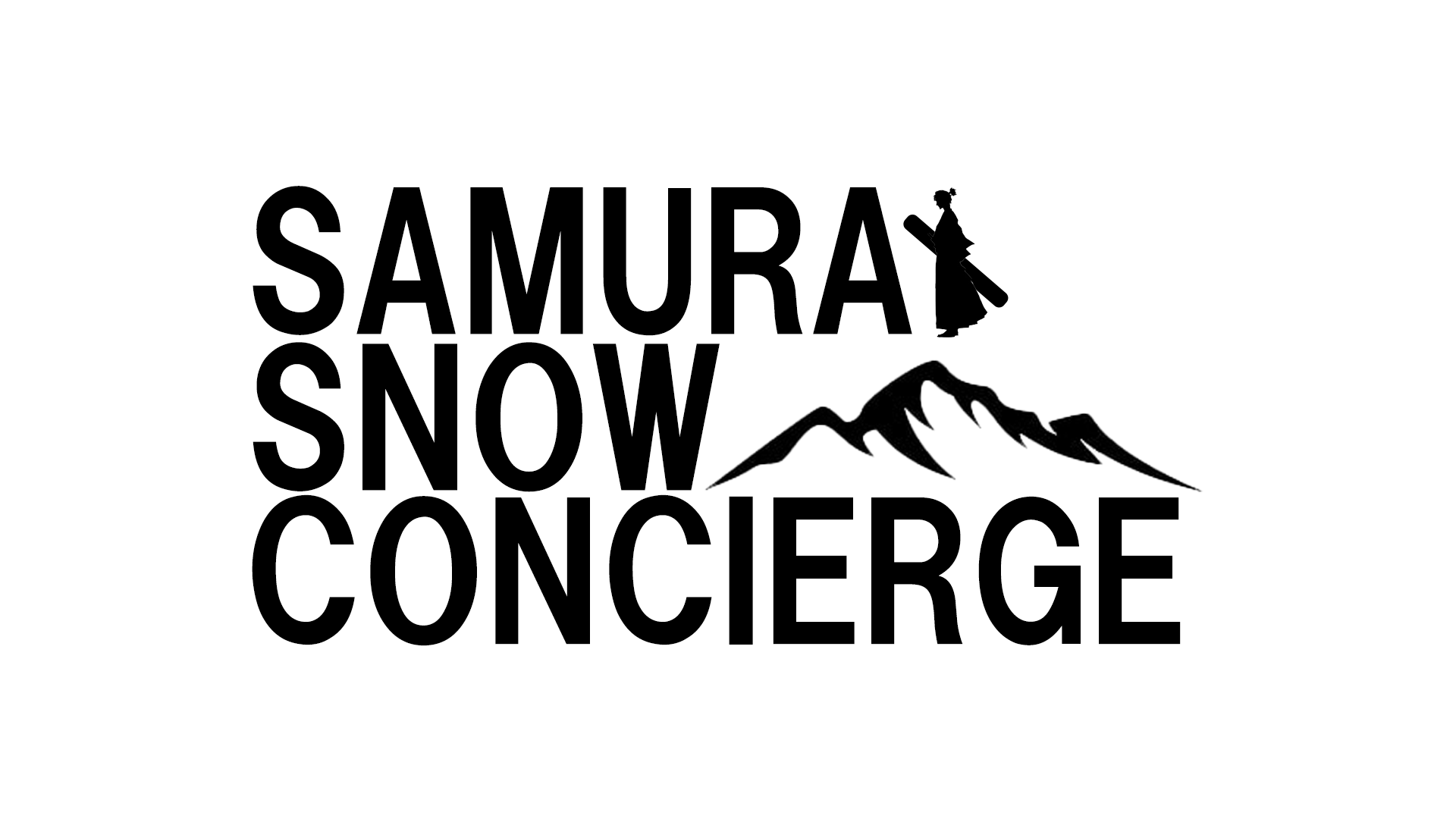
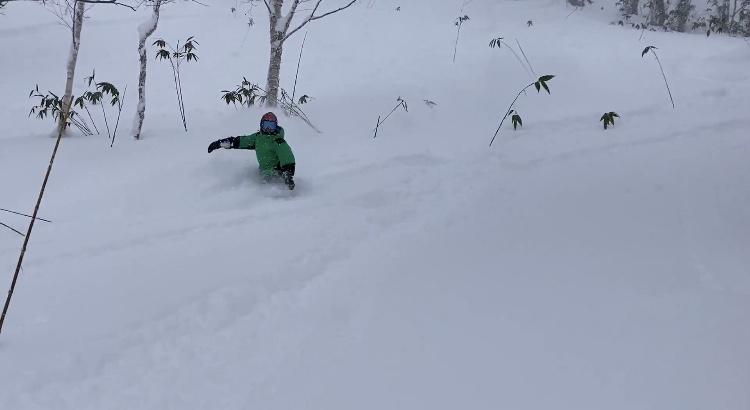


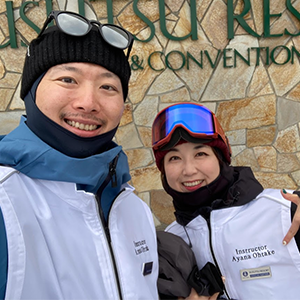








コメント